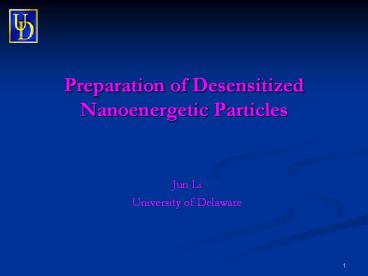Preparation of Desensitized Nanoenergetic Particles - PowerPoint PPT Presentation
Title:
Preparation of Desensitized Nanoenergetic Particles
Description:
Preparation of Desensitized Nanoenergetic Particles – PowerPoint PPT presentation
Number of Views:96
Avg rating:3.0/5.0
Title: Preparation of Desensitized Nanoenergetic Particles
1
Preparation of Desensitized Nanoenergetic
Particles
- Jun Li
- University of Delaware
2
Nanostructured Composite Energetic Materials
- Why?
- Nanostructured composite energetic materials
(mixing solid oxidizers and fuels at nanoscale) - Trade-off between power and energy density
- Less sensitivity
- Faster energy release rate
- Tailored energy properties and performance
- How?
- Conventional physical mixing incapability,
dangerous operation - Sol gel process or self-assembly nanoscale or
molecular mixing and intimacy, easiness of
synthesis
3
Sol Gel Process
4
Gelation and Drying
- Monolithic gel
- Polyol Energetic GAP polyol (OH functionality
2.7, Mn5500) - Nonenergetic polyol
- Cross-linkers isocyanate diyne and diene
- Chain extenders NC or THMNM
- Catalyst and concentration DBTDL
- Solvent Acetone or ethyl acetate
- Temperature
- High explosive CL-20
- Container
- Drying procedure
- Room temperature evaporation
- Anti-solvent precipitation and exchange
- Freeze-drying
5
Precursors and Chain Extenders
6
Cross-linkers
7
Optimized Synthesis and Processing
- Precursor mass ratio
- Catalyst concentration
- Volume ratio of HDI to DBTDL 310
- Temperature
- 40 0C
- Solvent
- Acetone or ethyl acetate
- Synthesis step
- One step
- Drying procedure
- Modified freeze-drying Flash freeze wet gel,
followed by low temperature vacuum evaporation
Precursor Mass ratio Max. CL-20 loading (wt) Lowest Conc. (mg/mL acetone)
GAP/HDI 90/10 85 68.78
NC/HDI 96/4 95 20.28
THMNM/HDI 37.46/62.56 90 41.6
NC/GAP/HDI 10/80.62/9.38 90 41.6
GAP/HDI/THMNM 40/39.20/20.80 90 78.23
GAP/TEGDA 85/15 90 87.88
GAP/HDI/TEGDA 87.5/5/7.5 90 87.88
NC/GAP/HDI/TEGDA 5/85.31/4.69/5 90 41.6
8
Porosity of Cryrogels
NC/HDI,96/4
GAP/HDI,90/10
THMNM/HDI,37.46/62.56
NC/GAP/HDI 10/80.62/9.38
GAP/HDI/THMNM 40/39.20/20.80
GAP/TEGDA, 85/15
9
SEM of Composite Energetic Materials__1
CL-20/GAP/HDI, 85/13.5/1.5
CL-20/NC/HDI, 90/9.6/0.4
CL-20/THMNM/HDI 90/3.33/6.67
10
SEM of Composite Energetic Materials__2
CL-20/GAP/HDI/THMNM, 90/4/3.92/2.08
CL-20/NC/GAP/HDI, 90/1/8.06/0.94
11
SEM of Composite Energetic Materials__3
CL-20/GAP/TEGDA 90/8.5/1.5
CL-20/GAP/HDI/TEGDA 90/8.75/0.5/0.75
CL-20/NC/GAP/HDI/TEGDA 90/0.5/8.53/0.47/0.5
12
FT-IR Spectra
CL-20/GAP/HDI Ser
CL-20/NC/GAP/HDI Ser
CL-20/GAP/HDI/THMNM Ser
- The polymorph of CL-20 ? ? ?
- No free NCO group
13
DSC
CL-20/GAP/HDI Ser
CL-20/NC/GAP/HDI Ser
CL-20/GAP/HDI/THMNM Ser
CL-20/NC/GAP/HDI/TEGDA Ser
Thermal stabilities composite energetic
materials lt CL-20, gels
14
Product Distribution
CL-20/GAP/HDI Ser
CL-20/NC/GAP/HDI Ser
CL-20/GAP/THMNM/HDI Ser
CL-20/NC/GAP/HDI/TEGDA Ser
15
Comparison
16
Sensitivity
Flyer Plate Impact Shock Sensitivity CL-20/NC/HDI
Impact Sensitivity
Measurements made by Dr. Brian Roos at ARL on UD
samples
17
Desensitizing Explanation
- Physical
- Particle size and size distribution
- Composite morphology homogenous or heterogeneous
- Polymer matrix hardness or elasticity
sensitivity - Thermal decomposition characteristics
- Thermal induced polymorphic phase transition
- Pure CL-20
- Effects of polymer matrix reduced phase
transition rate - Phase transition coupled with thermal
decomposition for composites with low Cl-20
loading
18
Morphology of CL-20/NC/GAP/HDI Composite
65 CL-20
50 CL-20
75 CL-20
90 CL-20
19
Solid Polymorphic Phase Transitions of CL-20
20
Arrhenius Parameters ? Extent of Conversion
Model-free method
21
Summary
- Up to 90 weight high explosive CL-20 can be
loaded easily in energetic polymer gels with
optimized compositions and processing. High
content of CL-20 in solution phase did not
disturb the formation of monolithic gels. - Energetic polymer matrices consist of micron and
submicron pores and nanometer thickness of
framework. - Drying procedure has a vital effect on the
nanostructure of composite materials. - Achieved homogeneity of explosive particles and
binders at nanometer and submicron scale. - The polymorph of CL-20 is mostly ? polymorph
after gelation and freeze-drying. - GAP polymer and CL-20 decomposed at similar onset
temperatures. The interaction of CL-20 with
polymer matrix resulted in slight lowing in
thermal stability. - Reduced the impact sensitivities of composite
energetic materials. - Product distributions of flash pyrolysis of
composite energetic materials were not sensitive
to CL-20 contents in the range of 50-90 weight
and gel compositions except one composite of
CL-20/NC/GAP/HDI/TEGDA at 90 weight CL-20.
Secondary reactions were promoted after ignition
because of intimacy of explosives and binders. - Model-free apparent activation energies for CL-20
solid polymorphic phase transitions of ?? ?, ??
?, and ?? ?, started at around 210 kJ/mol at 5
conversion, increased to the maxima of about 400
kJ/mol at 40, 80, and 60 conversion
respectively, and then decreased. - Polymer matrices decelerated phase transition
phase transitions coupled with thermal
decomposition of the composites with low CL-20
loading where thermal stability reduced.
22
Acknowledgements
Dr. Thomas B. Brill Brill Group Members Dr.
Bryce C. Tappan Dr. Brian Roos Dr. David
Miksa Dr. Brian Roos at ARL for sensitivity
test ATK for CL-20 MACH I for GAP Funding
Army Research Office, subcontract of
University of Minnesota, DURINT






























